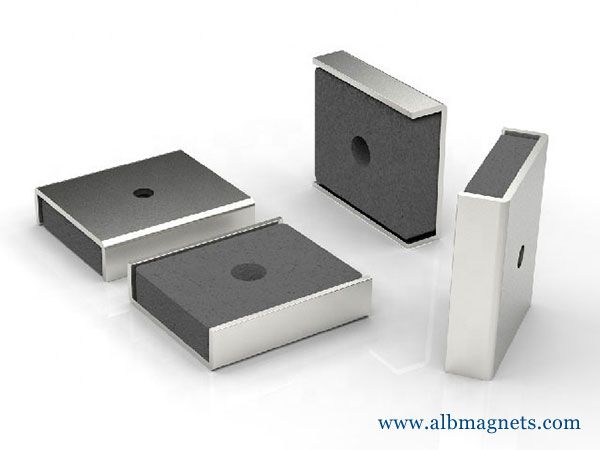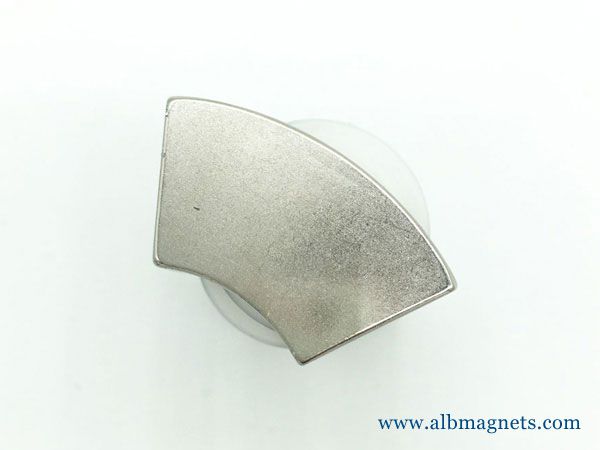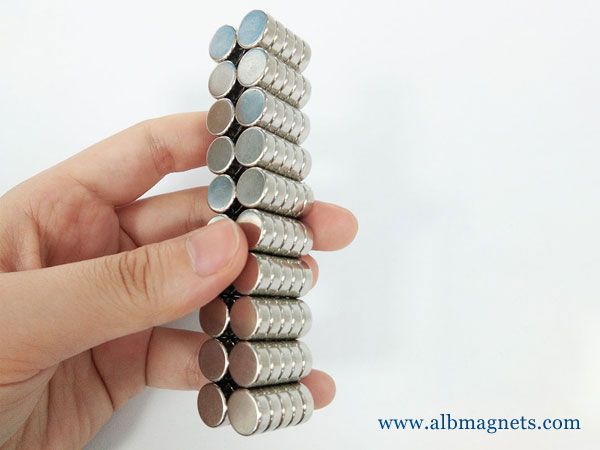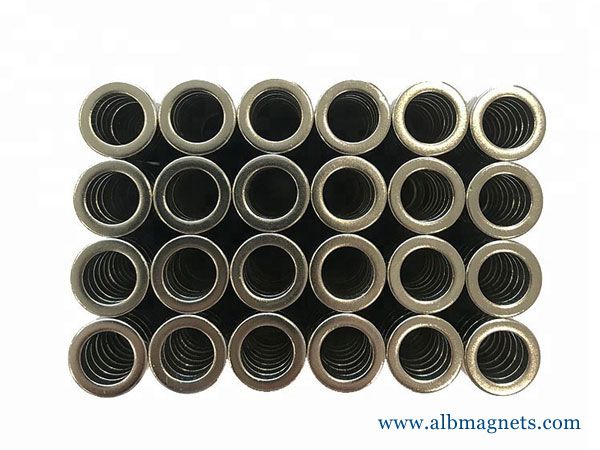401 Ryland St. Ste 200-A,
Reno, NV 89502
United States
E-mail: sales@albmaterials.com
- D-D5H2-N45 Neodymium Magnet, 5x2mm Disc Magnet
- B40x10x1.5mm Neodymium Magnet, 40 x 10 x 1.5mm Block Magnet
- D-D6H3-N45 Neodymium Magnet, 6x3mm Disc Magnet
- D68 Neodymium Magnets, 3/8 inch dia. x 1/2 inch thick
- B50x10x10mm Neodymium Magnet, 50 x 10 x 10mm Block Magnet
- B-W50H12L50-N52 Neodymium Magnet, 50x50x12mm Block Magnet
- R621 Neodymium Magnets, 3/8 inch od x 1/8 inch id x 1/16 inch thick
- BX88X8 Neodymium Magnets, 1 1/2 inch x 1/2 inch x 1 1/2 inch thick
- D6x14mm Neodymium Magnet, 6 x 14mm Cylinder Magnet
- B-W30H15L30-N52 Neodymium Magnet, 30x30x15mm Block Magnet
- POT07 Series Mounting Magnets and Pot Magnets
- D-D30H5-N38 Neodymium Magnet, 30x5mm Disc Magnet
- B60x20x2mm Neodymium Magnet, 60 x 20 x 2mm Block Magnet
- DY0A Neodymium Magnets, 2 inch dia. x 5/8 inch thick
- DY0X0-N52 Neodymium Magnets, 2 inch dia. x 1 inch thick
- B60x40x10mm Neodymium Magnet, 60 x 40 x 10mm Block Magnet
Scientists Create Ultra-Powerful Magnetic Field
New world record magnetic field
To reach the quantum limit or sustain nuclear fusion, scientists believe magnetic field strengths of 1,000 teslas or more may be needed.
A group of scientists at the University of Tokyo has recorded the largest magnetic field ever generated indoors -- a whopping 1,200 tesla, as measured in the standard units of magnetic field strength.
By comparison, this is a field strength about 400 times higher than those generated by the huge, powerful magnets used in modern hospital MRI machines, and it is about 50 million times stronger than Earth's own magnetic field.
Stronger magnetic fields have previously been achieved in outdoor experiments using chemical explosives, but this is a world record for magnetic fields generated indoors in a controlled manner.
That greater control means the discovery could open new frontiers in solid-state physics, perhaps allowing scientists to reach what is known as the "quantum limit," a condition where all the electrons in a material are confined to the lowest ground state, where exotic quantum phenomena may appear.
The high magnetic field also has implications for nuclear fusion reactors, a tantalizing if the unrealized potential future source of abundant clean energy.
To reach the quantum limit or sustain nuclear fusion, scientists believe magnetic field strengths of 1,000 teslas or more may be needed.
The experiments that set the new world record are described in an article appearing this week in the journal Review of Scientific Instruments, from AIP Publishing.
Record indoor magnetic field of 1200 T generated by electromagnetic flux-compression.
Record-Breaking Magnetic Field 50 Million Times Stronger
Scientists created a magnetic field around 50 million times stronger than the one surrounding Earth.
This is a new world record for a magnetic field generated indoors and, because of the level of control this provides, has major implications for material sciences and the development of nuclear fusion—a potential source of almost unlimited clean energy.
The team, from the University of Tokyo, generated a magnetic field reaching 1,200 teslas.
To put that into perspective, the magnets in the Large Hadron Collider at CERN measure eight teslas, while Earth's magnetic field is between 0.25 to 0.65 gauss—one tesla is the same as 10,000 gausses.
Far larger magnetic fields have been created outdoors using chemical explosives, but these are not much use when it comes to carrying out controlled experiments in a stable, indoor environment.
In their study, published in Review of Scientific Instruments, the team generated the magnetic field using the "electromagnetic flux-compression (EMFC) technique." This involves a metal cylinder being accelerated with a magnetic force until it undergoes a high-speed implosion.
Initially, a seed magnetic field is generated.
This is then compressed by the implosion into a small space, creating a strong magnetic field.
Shojiro Takeyama, one of the study authors, told Newsweek that the instrument they developed can be used for a wide variety of applications, including material sciences.
"We expect the magnetic field of an order of 1000 T can be quite useful for investigating the electronic properties of nano-materials," he said.
It also has implications for nuclear fusion technologies.
Fusion uses the same process to create energy as the sun.
The 100 million-degree plasma created in the process must be suspended inside a reactor, but as soon as the plasma touches the reactor wall the temperature drops and fusion is no longer possible.
As a result, there must be a cushion separating the reactor wall and the plasma—and this cushion is an intense magnetic field.
The newly developed machine could, in principle, be used to create the magnetic field—although Takeyam says there are no plans to apply their findings to plasma science at the moment.
As well as applying their research to other fields, the team also believes it is possible to create an even stronger magnetic field.
"According to our survey, our new instruments can generate at least 1500 T," he said, adding that more research will be needed to improve safety before they do this though.
This will be the world's biggest tokamak reactor.
Takeyama said it has taken four decades to reach this point and it has taken a "tremendous number" of trials and failures.
Daisuke Nakamura, the first author on the paper, added that their latest research opens up a new avenue of research.
"[The work] has pushed the envelope for ultrahigh magnetic fields," he said in a statement.
Clint Harper, a physics lecturer at the California State University Channel Islands who was not involved in the research, told Newsweek the announcement is a promising step forward for nuclear fusion: "One method of producing fusion reactions using hydrogen isotopes is to compress and heat the hydrogen nuclei using very strong magnetic fields," he said.
"This method, pioneered by the Russians, uses a system of magnetic confinement of the plasma called a tokamak which competes with the method of inertial confinement using very high-powered lasers pioneered by the U.S.
at facilities such as the Lawrence Livermore National Laboratory in northern California.
"The controlled production of extreme magnetic fields might give a significant boost to the Russian method of producing controlled hydrogen fusion which, in turn, could eventually lead to an efficient and clean power source."
Scott Feister, also from the CSU Channel Islands, added: "I'd emphasize that this is not a permanent magnet.
The magnetic field of 1200 Tesla is produced for a brief moment and in a small volume.
I'd expect a lot more work before this can be applied to tokamak-style fusion, and they don't claim anything of the sort in their paper.
Paul Goddard, a physicist with the U.K.'s University of Warwick, said 1,200 tesla is a "major increase" on what had previously been achieved.
"The dynamic and short-lived nature of the magnetic field may make experiments in this magnet technically challenge
Scientists create the most powerful indoor magnetic field
With magnetic fields above 1,000 teslas, you open up some interesting possibilities," Takeyama explained.
Physicists in Japan have created the strongest controllable magnetic field in recorded human history.
Not only the strongest field ever, but the magnetic field created by scientists at the University of Tokyo was sustained for a longer period than any other comparable magnetic field.
It reached such power that the field knocked the door to their lab off its hinges.
Four hundred times more powerful than an MRI, the magnetic field was created with a method known as electromagnetic flux compression.
The field measured out to 1,200 teslas, a unit of magnetic measurement.
While Russian scientists were able to create a magnetic field of an astonishing 2,800 teslas, their equipment blew up with the field.
"I designed the iron housing to endure against about 700 T,” says Takeyama to Spectrum IEEE.
The door was in an iron cupboard prepared for an assault of this nature, so no harm was done beyond to any researchers.
Since the machine created such a strong blast, bending and breaking an enclosure door, “next time I’ll make it stronger,” he says.
These sorts of machines are created for a very specific purpose: to create magnetic fields capable of studying solid-state physics.
Fields this strong can help to study, at the nanometer level, devices like semiconductors.
“In general, the higher the field, the resolution of measurement becomes better and better,” Takeyama tells Spectrum.
The field created by physicist Shojiro Takeyama and his team lasted much longer than the Russian field, relatively speaking, coming it at about 100 microseconds—about one-thousandth of the time it takes to blink according to the University of Tokyo.
Electromagnetic flux compression can generally reach levels of 1,000 teslas, and surpassing that number represents a crucial milestone for physics.
"With magnetic fields above 1,000 Teslas, you open up some interesting possibilities," says Takeyama in a press statement.
"You can observe the motion of electrons outside the material environments they are normally within.
So we can study them in a whole new light and explore new kinds of electronic devices.
This research could also be useful to those working on fusion power generation."
Electromagnetic flux compression can generally reach levels of 1,000 teslas, and surpassing that number represents a crucial milestone for physics.
"One way to produce fusion power is to confine plasma—a sea of charged particles—in a large ring called a tokamak in order to extract energy from it," he says.
"This requires a strong magnetic field in the order of thousands of teslas for a duration of several microseconds.
This is tantalizingly similar to what our device can produce."
It can also make some pretty cool explosions.
While it's not as stable as, say, bis-oxadiazole, it could be far more useful in everyday society.
As long as they get stronger doors.
In a magnetic milestone to make Nikola Tesla proud, scientists have created the strongest controllable magnetic field ever produced.
Energy crackled and sparks flew back when physicists from the Institute for Solid State Physics at the University of Tokyo powered up their 400 million amp megagauss generator system.
That’s hundreds of times the current of an average lightning bolt.
The device was created by the University of Tokyo physicist Shojiro Takeyama and his team.
And it generated a whopping 1,200 teslas – a unit of magnetic field strength – for around 100 microseconds.
Surpassing that 1,000-tesla threshold is considered a significant achievement.
“With magnetic fields above 1,000 teslas, you open up some interesting possibilities,” Takeyama said in a press release last week.
“You can observe the motion of electrons outside the material environments they are normally within.
So we can study them in a whole new light and explore new kinds of electronic devices.
This research could also be useful to those working on fusion power generation.”
The achievement marks one of the strongest artificial magnetic fields ever created.
However, the top mark goes to a Russian team in 2001 who generated 2,800 teslas before their equipment blew up.
"And they try to make a scientific measurement, but because of these conditions it's very hard to make precise measurements."
Other forms of superstrong magnetic fields require lasers, but Takeyama said that the laser-generated fields are tiny and supershort-lived, even by physics standards, making them similarly problematic for the sorts of experiments in which he and his laboratory colleagues at the University of Tokyo are interested.
The point of building a magnet in the 1,000-plus tesla range, Takeyama said, is to study hidden physical properties of electrons that are invisible under normal circumstances.
He and his team will put different materials inside their magnet to study how their electrons behave.
Under those extreme conditions, he said, conventional models of electrons break down.
Takeyama doesn't know exactly what happens to electrons in such extreme situations, but said that studying them in the moments before the coil's self-destruction should reveal properties of electrons normally invisible to science.
Extremely powerful magnetic fields also have possible applications in fusion engineering , to keep the hot plasmas of a fusion reaction contained and far from their container walls.
The problem with building magnetic fields that powerful is that, as in the case of Takeyama's magnet, they almost, by definition, destroy themselves within moments of their creation.
The field — and the process of creating it — inevitably exerts so much energy on the device generating it that at least some element of the device burns out or collapses on itself.
Takeyama said that the advantage of his magnetic field is that it's relatively robust compared with fields generated by lasers or explosive devices.
It's large enough to contain a substantial amount of material, requires no explosives and has a life span of a few dozen microseconds (millionths of a second).
That's short in human terms, but it lasts several times longer than those laser-generated fields.
Also, while the coil itself is destroyed, the surrounding machine survives the process largely intact.
Here's what happened when it was powered up to 3.2 megajoules for the experiment that produced the 1,200-tesla field:
The device is contained and nondestructive compared with those explosive experiments in Siberia and Los Alamos.
But still, every time the magnet is used, Takeyama and his team must enter the room and begin the long, laborious process of cleanup and repairs, he said.
His research team must fabricate a new magnetic coil to exquisitely precise dimensions for each use.
The typical wait time between experiments, he said, is about two to five months.
Outside researchers interested in elusive fusion-power generators have expressed interest in Takeyama's research as possibly useful for their large, magnetic plasma containment systems, he said.
However, he said he's not certain how useful his fields might be in that context, nor is that his primary goal.
Down the road, he said, he expects to amp up the power on his machine, eventually maxing it out at the 5-megajoule, 1,800-tesla mark.
But he's in no rush to get to that point, he said.
First, he and his team want to explore as much as possible what they can learn at the 3.2-megajoule, 1,200-tesla range.
And there remains the problem of safety as the energies involved increase.
For now, he said, his team has added some stronger doors to his lab.
Unit Conversion Table of Magnetic Flux Density
Magnetic Field Unit conversion Tool: Unit conversion of magnetic flux density and ... And when it is defined by flux density, the units of G (Gauss) or T (Tesla) are ...
We will propose solutions with sensor development and sensor built-in high functional units.
Magnetic Field Unit conversion Tool
Unit conversion of magnetic flux density and magnetic field density can be made by the following tool.
Input figures by selecting units from the pull-down menu.
Input figure
unit before conversion Gauss[G]
unit after conversion Gauss[G]
Magnetic field strength is defined by vector field which has a direction and a magnitude (or strength).
The number of magnetic flux lines that go through the unit area perpendicular to the magnetic field is called Flux density B.
The relation between Magnetic strength H and flux density B can be defined by B = μH.
μ, in this case, is permeability, the unit of magetizability.
In the air, μis usually about 1, except the special case, and 1 Gauss ≒ 1 Oersted.
Usually, the magnetic field strength is defined by the unit of Oe・A/m ( Oersted・Ampere/meter ).
And when it is defined by flux density, the units of G (Gauss) or T (Tesla) are used.
This means that flux density B is a value that includes magnetizability and magnetic flux H does not include magnetizability.
In many cases, Residual magnetic flux density (Br) and Magnetic coercive force (Hc) are used to define properties of permanent magnets.
Oe (Oersted) is used to define the Magnetic coercive force as it is the strength of the magnetic field to reverse the direction of the magnetic pole.
Watch Scientists Accidentally Blow Up Their Lab With The Strongest Indoor Magnetic Field Ever
Researchers at the University of Tokyo were expecting to create a strong magnetic field, but they got a lot more than they were bargaining for.
Earlier this year, researchers at the University of Tokyo accidentally created the strongest controllable magnetic field in history and blew the doors of their lab in the process.
As detailed in a paper recently published in the Review of Scientific Instruments, the researchers produced the magnetic field to test the material properties of a new generator system.
They were expecting to reach peak magnetic field intensities of around 700 Teslas, but the machine instead produced a peak of 1,200 Teslas.
(For the sake of comparison, a refrigerator magnet has about 0.01 Tesla)
This is the strongest magnetic field ever generated in a controlled, indoor environment, but it’s not the strongest magnetic field produced in history.
This honor belongs to some Russian researchers who created a 2,800 Tesla magnetic field in 2001.
In both the Japanese and Russian experiments, the magnetic fields were generated using a technique called electromagnetic flux-compression.
This technique causes a brief spike in the strength of the magnetic field by rapidly “squeezing” it to a smaller size.
This technique has been around since the 1940s, but in the early days, it relied on using large amounts of TNT to generate an explosion powerful enough to compress the magnetic field.
The downside of this technique was that it could only be done once since the explosion destroyed the equipment.
Furthermore, it was difficult to reproduce and control the explosion.
Instead of using TNT to generate their magnetic field, the Japanese researchers dumped a massive amount of energy—3.2 megajoules—into the generator to cause a weak magnetic field produced by a small coil to rapidly compress at a speed of about 20,000 miles per hour.
This involves feeding 4 million amps of current through the generator, which is several thousand times more than a lightning bolt.
When this coil is compressed as small as it will go, it bounces back.
This produces a powerful shockwave that destroyed the coil and much of the generator.
To protect themselves from the shockwave, the Japanese researchers built an iron cage for the generator.
However they only built it to withstand about 700 Teslas, so the shockwave from the 1,200 Teslas ended up blowing out the door to the enclosure.
“I didn’t expect it to be so high,” Shojiro Takeyama, a physicist at the University of Tokyo, told IEEE Spectrum.
“Next time, I’ll make [the enclosure] stronger.”
According to the researchers, this experiment not only provides insight into how different materials respond to strong magnetic fields but may also find applications in the quest to produce fusion energy.
Many leading fusion reactor designs require the application of strong magnetic fields on the order of thousands of Teslas for short periods of time, a requirement that the researchers said was “ tantalizingly similar ” to what they had produced.
Read More: We Were Promised Fusion Energy
After making some adjustments to the generator and rebuilding the iron cage, the researchers plan to pump 5 megajoules of energy into the generator next time, which should around 1,500 Teslas.
“Only 40 years ago, magnetic fields of the order of 1000 Tesla were only reported in extremely complicated and sometimes unreliable explosively-driven systems, without any of the sophisticated levels of control,” the researchers concluded in their report.
“Therefore, one can say without any doubt, that the present results represent the beginning of a new era in the quest of producing and using ultrahigh magnetic fields for solid-state studies as well as for plasma fusion related experiments.”
Part of the content in this article is reproduced from other media for the purpose of transmitting more information and does not mean that this website agrees with its views or confirms the authenticity of its content. It shall not bear direct responsibility and joint liability for the infringement of such works.
If there is any infringement, bad information, error correction, and other issues in the content of this page, please contact us at info@albmaterials.com
Link to this article: https://www.albmagnets.com/blog/scientists-create-ultra-powerful-magnetic-field.html
How to choose and buy a strong neodymium magnet? ALBMagnets is a professional company for strong magnet design and manufacturing,
providing you with reliable N35, N38, N42, N52, N42SH and other grade super neodymium magnets and SmCo rare earth magnets.












